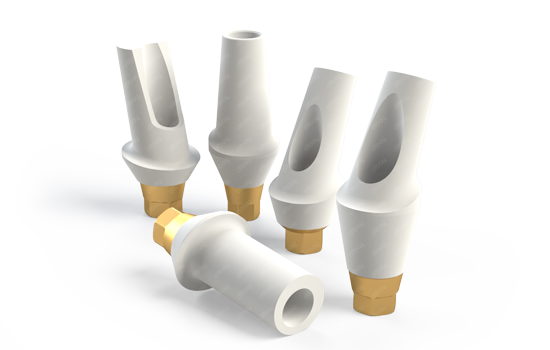Zirconia Abutment | EM™ - Dental Implant components online


Zirconia Abutments
Reinforced with a titanium base, EM zirconia abutments offer the additional benefit of high torque capacity.
Zirconia Implant Abutments
For maximum strength of its ceramic abutments, Edison Medical utilizes Yttria Partially Stabilized Zirconia (YTZP). Abutments produced from this class of zirconia (also known as zirconium dioxide) are most resilient to wear, force, abrasion and corrosion in comparison with other ceramics.
Zirconia is an ideal material for implant abutments in restoration scenarios where esthetics and metal allergies may be of concern. Edison Medical’s Zircocam™ zirconia implant abutments are reinforced with a titanium base and each abutment comes with a titanium fixation screw.
Zircocam™ abutments are available in both regular and narrow platforms, and in three angulations: straight, 15°or 25°. Each angulation is available in three different collar heights and total lengths. EM’s Zircocam™ abutments are compatible with more than 70 implant system brands, including Astra Tech®, Straumann®, Zimmer®, Nobel Active®, Osstem® / Hiossen®, MegaGen®.
Zirconia as an implant abutment material
Among the different materials that make up today’s implant abutments, the zirconia implant abutment both rivals and stands apart from its metal homolog in several ways.
Zirconium dioxide abutments are the strongest of ceramic abutments, exhibiting a monoclinic crystalline structure at room temperature that, with increasing temperature, transitions to tetragonal and cubic crystalline structures. Physical, chemical and esthetic properties that are crucial for a high quality implant abutment include high strength, biocompatibility, and a natural-looking esthetic.
To achieve these properties with raw, mined zircon (ZrSiO₄), several metal oxides can be added: yttrium oxide (Y2O₃), magnesium oxide (MgO), cerium(III) oxide (Ce₂O₃), and calcium oxide (CaO). The addition of these metal oxides serves to stabilize the zirconium’s tetragonal crystalline phase, prevent water corrosion, and reduce pore development and coloring components. The resulting zirconia has a similar clinical performance to titanium with regard to esthetic, technical and biological outcomes.
From a microbiological perspective, zirconia has been shown to have low bacterial adhesion, which means lower risk of periodontal issues around the restoration.
Furthermore, zirconia provides an alternative to metal abutments for patients that have allergies or sensitivities to metal. Metal-free zirconia abutments have a high resistance to corrosion that can be caused by acids in the oral environment.
The caveat of zirconia implant abutments and its remedy
Satisfaction with use of zirconia abutments is divided among dental professionals, with some prosthodontists enthusiastically incorporating them into their practice, while others see only certain scenarios as fit for implementation of zirconia.
The tooth color of zirconia makes it an excellent option where esthetics and emergence profile are of concern, but there are no two ways about it: zirconia is more prone to fracture than titanium. Implant abutment manufacturers have remedied this issue where necessary by placing a titanium core in the zirconia implant abutment.
Granted that no allergy issues exist, the presence of this titanium core has several advantages. Titanium, being a stronger material than zirconia, is less susceptible to breakage and thus reinforces the abutment. In addition, the metal-on-metal implant-abutment interface is much stronger than a mixed-material interface, which reinforces the restoration system as a whole.
When to use zirconia abutments
Due to some issues that can arise with the use of zirconia implant abutments, it is important to clarify when their use is acceptable.
As mentioned, zirconia abutments are of particular advantage in scenarios where esthetics are of concern and the restoration demands a tooth-colored abutment. Given today’s variety of materials available for restoration and the skill of a good ceramicist, many esthetically sensitive restorations are possible without zirconia implant abutments.
The other matter is that of force exerted on the abutment. In the case that a tooth-colored abutment is necessary and thus zirconia is the material of choice, it is advisable to only carry out the restoration if forces around the abutment can be minimized and therefore risk of fracture is reduced.
In more trying cases of breakage, particularly involving pure zirconia abutments (without a titanium core), the break of the abutment can also cause breakage of the implant, leading to difficulties in removing one or both of these pieces. This risk further supports the use of the hybrid zirconia-titanium abutment, which Edison Medical offers exclusively.
What is a zirconia abutment?
A zirconia abutment is a dental implant abutment made from pure zirconium oxide or that in combination with other stabilizing metal oxides such as yttria or magnesia. Zirconia abutments are resilient to wear, force, abrasion and corrosion in comparison with other ceramics, making them the strongest of ceramic abutments. These abutments also feature excellent physical and chemical properties, and are highly regarded for their biocompatibility and natural-looking aesthetic. They are ideal for use in restoration scenarios where esthetics and metal allergies may be of concern.
shop & filter by brand





